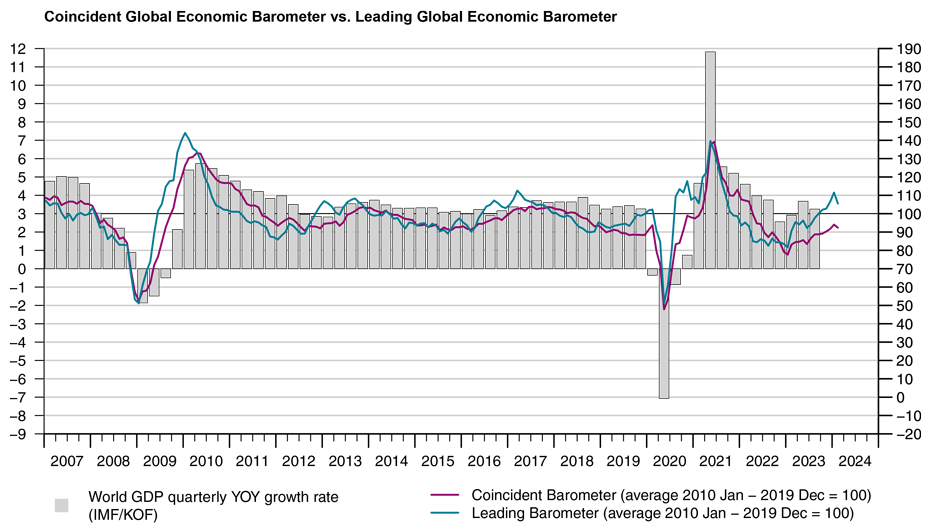Global Economic Barometers fail to continue their upward series
After seven consecutive months of increases, the Global Barometers decline in February. The Coincident Barometer remains below average, while the Leading Barometer remains above average. This decline is a warning that the recovery process is fragile.

In February, the Coincident Global Economic Barometer falls by 1.6 points and the Leading Barometer by 6.0 points to 92.4 and 105.5 points, respectively. In both cases, the Asia, Pacific & Africa region is the largest contributor to the decline, with the other regions contributing more discreetly in different directions. The gap between the two indicators has narrowed this month, but remains high at 13.1 points.
“This month the barometers report a clear bump in the road to recovery. As this setback is almost entirely driven by data from the Asian region, and is most visible in construction-related data, it is likely that the direct and indirect consequences of the problems in China's housing sector are at least part of the story. However, with the overall leading indicator still well above both its long-term average and the overall coincident indicator, the overall picture remains one of a recovering global economy” evaluates KOF director Jan-Egbert Sturm the latest results.

“This month the barometers report a clear bump in the road to recovery. However, the overall picture remains one of a recovering global economy.”Jan-Egbert Sturm, Director of KOF Swiss Economic Institute
Coincident Barometer – regions and sectors
The decline in the Coincident Barometer in February is mainly driven by the indicator for the Asia, Pacific & Africa region, with a negative contribution of -1.6 points, as the contributions from Europe and the Western Hemisphere of -0.2 and +0.2 points, respectively, offset each other this month. The regional coincident indicators continue to hover above the 90 mark, pointing to a modest recovery in world economic activity.
Among the Coincident sector indicators, all declined in February, particularly Construction, which returned to the 80-point range, and recorded the lowest level among the indicators.
Leading Barometer – regions and sectors
The Leading Global Barometer leads the world economic growth rate cycle by an average of three to six months. In February, the largest negative contribution comes from the Asia, Pacific & Africa region, with -6.1 points. The Western Hemisphere makes a modest contribution of -0.2 points, while Europe moves in the opposite direction, adding 0.3 points to the final indicator. The indicator for the Asia, Pacific & Africa region reflects a revision of the positive outlook recorded in the previous month, while the expectations for Europe and the Western Hemisphere remain side-by-side at a level that is still favorable.
In February, all the Leading sector indicators declined, with Economy (aggregated business and consumer evaluations) being the only one to register a level below 100 points.

The Global Economic Barometers
The Global Economic Barometers are a system of indicators enabling timely analysis of global economic development. They represent a collaboration between the KOF Swiss Economic Institute of the ETH Zurich in Switzerland and Fundação Getulio Vargas (FGV), based in Rio de Janeiro, Brazil. The system consists of two composite indicators, the Coincident Barometer and the Leading Barometer. The Coincident Barometer reflects the current state of economic activity, while the Leading Barometer provides a cyclical signal roughly six months ahead of current economic developments.
The two Barometers comprise the results of economic tendency surveys conducted in more than 50 countries with the aim of achieving the broadest possible global coverage. The advantages of economic tendency surveys are that their results are usually readily available and are not substantially revised after first publication.
The Coincident Barometer includes more than 1,000 different time series, while the Leading Barometer consists of over 600 time series. Cross-correlation analysis is used to decide which individual time series are included in the barometers. This involves correlating the individual time series with a reference series. The reference series used is the year-on-year growth rate of global gross domestic product (GDP), where the individual national GDPs are aggregated at purchasing power parity to form global GDP. A time series is only included in a Barometer if it shows a sufficiently high correlation and a suitable synchronization or lead with the reference series. The time period used for this correlation analysis currently runs from January 2010 to December 2019.
The series of the two Barometers are revised each month at publication and are standardized to have a mean of 100 and a standard deviation of 10 for the 10-year period previous to the most recent observations.
The methodology is described in:
Klaus Abberger, Michael Graff, Aloisio Jr. Campelo, Anna Carolina Lemos Gouveia, Oliver Müller and Jan-Egbert Sturm (2020), The Global Economic Barometers: Composite indicators for the world economy. KOF Working Papers, vol. 471, Zurich: KOF Swiss Economic Institute, ETH Zurich, 2020.
Contact
KOF Konjunkturforschungsstelle
Leonhardstrasse 21
8092
Zürich
Switzerland
